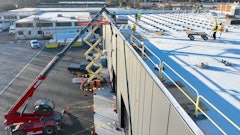The Associated General Contractors of America (AGC) commemorated the 40th anniversary of Earth Day (April 22, 2010) with the release of a detailed green construction plan entitled "Building a Green Future." In the introductory paragraph the AGC writes, "You can't wish for a green future - you have to build it."
In this document, the AGC makes recommendations on adjusting government policies, establishing or expanding tax incentives, and increasing government funding to improve the environmental performance of U.S. buildings and infrastructure. The two strongest benefits that could come from these recommendations would include decreasing energy consumption in the United States and giving the construction industry a boost by getting workers back on jobsites and expanding their educational opportunities through "green jobs" training.
The AGC detailed a few sectors that could use a dose of green:
- Buildings. The AGC suggests modernizing government buildings, supporting the Building STAR Energy Efficiency Rebate Act in Congress which would offer rebates and incentives for energy efficient improvements in commercial buildings, and expanding tax incentives for owners who build green.
- Transportation. The report points out that traffic congestion wasted 2.8 billion gallons of fuel in 2007. The AGC wants to see investment levels doubled in federal highway transit, aviation, freight and rail programs, focusing on increasing highway capacity and improving traffic flow at 233 defined bottlenecks across the country.
- Water infrastructure. The AGC wants to see the government fully fund programs to maintain and improve drinking water infrastructure and wastewater treatment facilities.
- Contaminated and brownfield sites. The AGC would like the government to offer incentives to developers to make contaminated and brownfield sites more attractive to develop over virgin land and support cleanup training for the construction industry.
- Power generation. As the AGC report points out, the act of generating power uses power - 34 percent of green house gas emissions in 2008 were from emissions from electricity generation. The AGC wants to see a national energy plan that promotes hydropower, biomass, nuclear, wind, solar and geothermal energy and offers construction workers training in these jobs.
- Greening construction. The AGC notes contractors can take voluntary steps in their businesses to run green - adopt a "no idling" policy, use alternative fuels, update fleets with the latest technologies, partake in jobsite recycling and reuse initiatives - but suggests the government encourage these steps with grant programs and support of reuse initiatives.
I suggest you take a look at the report yourself, available at www.agc.org. Communicating the recommendations from the AGC to your local leaders in government will help turn the AGC's suggestions into economic activity for the construction industry.
Another step I encourage you to take is e-mail me about what you're company is doing to work toward a greener future. What steps have you taken to reduce your energy consumption? What services do you offer that contribute to a green construction project?
Does your stormwater management plan go beyond the government requirements? Do you push the envelope when it comes to recycling and reusing materials? Please e-mail me at [email protected] and let me know how your company is helping to build a greener future.

![Img 1707[56]](https://img.forconstructionpros.com/files/base/acbm/fcp/image/2023/04/IMG_1707_56_.6437076c97961.png?auto=format%2Ccompress&fit=crop&h=191&q=70&rect=0%2C462%2C1920%2C1080&w=340)
















![Glp Porsche 072723 465 64ee42287c29e[1]](https://img.forconstructionpros.com/files/base/acbm/fcp/image/2024/03/GLP_PORSCHE_072723_465.64ee42287c29e_1_.65e88b8589b9c.png?auto=format%2Ccompress&fit=crop&h=135&q=70&rect=0%2C520%2C2250%2C1266&w=240)







